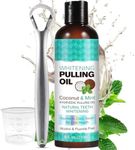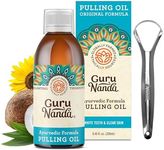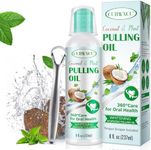Buying Guide for the Best Pulling Oils
When choosing a pulling oil for oil pulling (an oral health practice where you swish oil in your mouth), it's important to focus on the quality, type, and purity of the oil. The right oil can make the process more pleasant and effective, while the wrong one might not deliver the benefits you’re looking for. Understanding the key specifications will help you select an oil that matches your preferences and health goals.Type of OilThe type of oil refers to the base ingredient used, such as coconut, sesame, or sunflower oil. This is important because different oils have unique flavors, textures, and potential health benefits. Coconut oil is popular for its mild taste and natural antibacterial properties, while sesame oil is traditional in Ayurvedic practices and has a nuttier flavor. Sunflower oil is lighter and more neutral. If you prefer a sweeter, milder taste, coconut oil might be best. For a more traditional or earthy experience, sesame oil is a good choice. Consider your taste preferences and any allergies when picking the type.
Purity and ProcessingPurity and processing describe how the oil is made and whether it contains any additives. Cold-pressed and unrefined oils are less processed and retain more natural nutrients, which can be beneficial for oral health. Refined oils may have a lighter taste but could lose some beneficial compounds. If you want the most natural product, look for oils labeled as 'cold-pressed,' 'unrefined,' or 'virgin.' Avoid oils with added flavors, preservatives, or chemicals, especially if you are sensitive to additives.
Organic CertificationOrganic certification means the oil is made from ingredients grown without synthetic pesticides or fertilizers. This is important if you want to avoid potential chemical residues in your oil. Oils with organic certification are generally considered safer and more environmentally friendly. If you prioritize natural and clean products, look for oils with a recognized organic label.
Flavor and AromaFlavor and aroma refer to the taste and smell of the oil, which can affect your oil pulling experience. Some oils have a strong, distinctive taste, while others are mild or even tasteless. If you are sensitive to strong flavors or plan to use oil pulling daily, a milder oil may be more pleasant. Try a small amount first to see if you like the taste and smell before committing to a larger bottle.
Texture and ConsistencyTexture and consistency describe how thick or thin the oil feels in your mouth. Some oils, like coconut oil, are solid at cooler temperatures and melt in your mouth, while others, like sesame or sunflower oil, are always liquid. If you prefer a smooth, easy-to-swish oil, choose one that stays liquid at room temperature. If you like a richer, creamier feel, coconut oil might be appealing, especially if you don’t mind it starting out solid.










